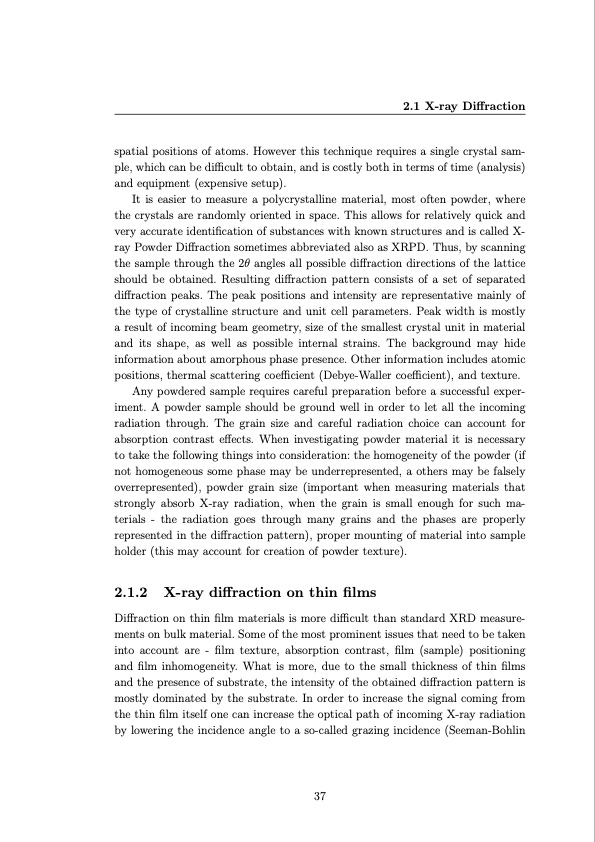
PDF Publication Title:
Text from PDF Page: 058
2.1 X-ray Diffraction spatial positions of atoms. However this technique requires a single crystal sam- ple, which can be difficult to obtain, and is costly both in terms of time (analysis) and equipment (expensive setup). It is easier to measure a polycrystalline material, most often powder, where the crystals are randomly oriented in space. This allows for relatively quick and very accurate identification of substances with known structures and is called X- ray Powder Diffraction sometimes abbreviated also as XRPD. Thus, by scanning the sample through the 2θ angles all possible diffraction directions of the lattice should be obtained. Resulting diffraction pattern consists of a set of separated diffraction peaks. The peak positions and intensity are representative mainly of the type of crystalline structure and unit cell parameters. Peak width is mostly a result of incoming beam geometry, size of the smallest crystal unit in material and its shape, as well as possible internal strains. The background may hide information about amorphous phase presence. Other information includes atomic positions, thermal scattering coefficient (Debye-Waller coefficient), and texture. Any powdered sample requires careful preparation before a successful exper- iment. A powder sample should be ground well in order to let all the incoming radiation through. The grain size and careful radiation choice can account for absorption contrast effects. When investigating powder material it is necessary to take the following things into consideration: the homogeneity of the powder (if not homogeneous some phase may be underrepresented, a others may be falsely overrepresented), powder grain size (important when measuring materials that strongly absorb X-ray radiation, when the grain is small enough for such ma- terials - the radiation goes through many grains and the phases are properly represented in the diffraction pattern), proper mounting of material into sample holder (this may account for creation of powder texture). 2.1.2 X-ray diffraction on thin films Diffraction on thin film materials is more difficult than standard XRD measure- ments on bulk material. Some of the most prominent issues that need to be taken into account are - film texture, absorption contrast, film (sample) positioning and film inhomogeneity. What is more, due to the small thickness of thin films and the presence of substrate, the intensity of the obtained diffraction pattern is mostly dominated by the substrate. In order to increase the signal coming from the thin film itself one can increase the optical path of incoming X-ray radiation by lowering the incidence angle to a so-called grazing incidence (Seeman-Bohlin 37PDF Image | Investigation of metal-insulator transition in magnetron sputtered samarium nickelate thin films

PDF Search Title:
Investigation of metal-insulator transition in magnetron sputtered samarium nickelate thin filmsOriginal File Name Searched:
Bilewska_Investigation_of_metal_insulator_transition_in_magnetron_sputtered_samarium.pdfDIY PDF Search: Google It | Yahoo | Bing
Sulfur Deposition on Carbon Nanofibers using Supercritical CO2 Sulfur Deposition on Carbon Nanofibers using Supercritical CO2. Gamma sulfur also known as mother of pearl sulfur and nacreous sulfur... More Info
CO2 Organic Rankine Cycle Experimenter Platform The supercritical CO2 phase change system is both a heat pump and organic rankine cycle which can be used for those purposes and as a supercritical extractor for advanced subcritical and supercritical extraction technology. Uses include producing nanoparticles, precious metal CO2 extraction, lithium battery recycling, and other applications... More Info
| CONTACT TEL: 608-238-6001 Email: greg@infinityturbine.com | RSS | AMP |